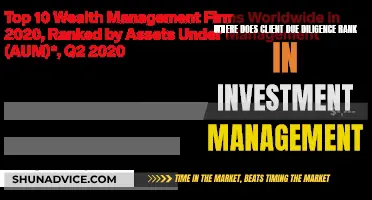
All investments carry some degree of risk, but not all investments carry the same amount of risk. The main risk of investing is the possibility of losing money – you might not get back what you put in. There are two types of investment risk: systematic risk and unsystematic risk. Systematic risk affects the prices of all comparable investments and refers to the economic, political, and sociological factors that impact all securities to varying degrees. Unsystematic risk, on the other hand, is the portion of investment risk that is unique to a firm, industry, or property, and can be reduced through diversification.
Different types of investments carry different amounts of risk. For example, lower-risk investments typically contain a mix of cash and fixed-income assets, while higher-risk investments may have more equities. Examples of low-risk investments include savings accounts, certificates of deposit (CDs), money market accounts, and bonds. Higher-risk investments include stocks, mutual funds, and exchange-traded funds (ETFs).
The amount of risk an investor is willing to take depends on their risk tolerance and risk capacity. Risk tolerance refers to an investor's comfort level with taking on risk, while risk capacity is the amount of financial risk an investor can take on given their current financial situation. It's important for investors to understand their risk tolerance and capacity before making investment decisions.
| Characteristics | Values |
|---|---|
| Possibility of losing money | High |
| Variability of returns | High |
| Possibility of losing some or all of an original investment | High |
| Possibility of losing money on an investment | High |
| Probability that the actual return of an investment will differ from its expected return | High |
| Risk tolerance | Depends on the investor |
| Risk capacity | Depends on the investor |
| Risk appetite | Depends on the investor |
| Time horizon | Depends on the investor |
| Bankroll | Depends on the investor |
| Risk-reward | The higher the risk, the higher the reward |
| Systematic risk | Cannot be diversified away |
| Unsystematic risk | Can be diversified away |
| Total risk | Systematic risk + Unsystematic risk |
What You'll Learn

Systematic risk vs unsystematic risk
Investment risk can be broadly categorized into two types: systematic risk and unsystematic risk. While systematic risk affects the prices of all comparable investments, unsystematic risk is unique to a specific company, industry, or asset. Both types of risks are inherent in the market, but they differ in terms of scope, nature, underlying factors, and the strategies used to mitigate them.
Systematic risk, also known as market risk, is caused by macroeconomic factors beyond the control of individual businesses or investors. These factors include economic, political, and sociological influences, such as interest rate changes, inflation, recessions, currency fluctuations, and natural disasters. For instance, the COVID-19 pandemic impacted the entire stock market, serving as a systematic risk. Systematic risk cannot be diversified away and is inherent in the market. However, it can be mitigated through asset allocation and hedging strategies.
On the other hand, unsystematic risk is specific to a particular company, industry, or asset. It arises from internal and external factors that affect a single organization or a group of closely related organizations. Examples include labor strikes, regulatory changes, management issues, financial risks, and competition. Unsystematic risk can be mitigated through diversification, making it also known as diversifiable risk. By investing in a range of companies across different industries, investors can reduce their exposure to unsystematic risks.
The key differences between systematic and unsystematic risk can be summarized as follows:
- Impact: Systematic risk has the potential to affect entire industries and the overall economy, while unsystematic risk typically impacts individual organizations or specific sectors.
- Nature: Systematic risks are unavoidable and uncontrollable, whereas unsystematic risks are generally avoidable and controllable.
- Factors: Systematic risks stem from external macroeconomic factors, whereas unsystematic risks result from internal or closely related external microeconomic factors.
- Protection: Systematic risk can be mitigated through asset allocation, while unsystematic risk can be reduced by diversifying investment portfolios.
- Avoidability: Systematic risks cannot be avoided, but unsystematic risks can be mitigated or avoided through diversification.
- Types: Systematic risks include interest rate risk, inflation risk, purchasing power risk, and market risk. In contrast, unsystematic risks are specific to businesses and finances.
Understanding the distinction between systematic and unsystematic risk is crucial for investors to make informed decisions, navigate market volatility, and implement effective risk mitigation strategies.
Risk Factors: Understanding the Most Risky Investments
You may want to see also

Risk and return
All investments carry some degree of risk, but not all investments carry the same amount of risk. The main risk of investing is the possibility of losing money – you might not get back what you put in. There are varying degrees of risk, and some investments are considered safer than others.
Types of Risk
Risk can be broadly categorised into two types: systematic risk and unsystematic risk. Systematic risk, also known as market risk, affects the prices of all comparable investments. It includes factors such as interest rate risk, market risk, reinvestment rate risk, purchasing power or inflation risk, and currency or exchange rate risk. Unsystematic risk, on the other hand, is specific to a particular company, industry, or property. It includes factors such as business risk, financial risk, credit risk, downgrade risk, liquidity and marketability risk, and event risk.
Managing Risk
While it is impossible to eliminate investment risk, it can be managed through diversification and hedging strategies. Diversification involves putting your money into a range of different investments, so that if one investment performs poorly, it can be balanced out by others. Hedging involves buying a security to offset the potential loss on another investment. Additionally, individuals can assess their risk tolerance, which is the amount of risk they are willing and able to accept, to help them make informed investment decisions.
Examples of Low-Risk and High-Risk Investments
Examples of low-risk investments include savings accounts, certificates of deposit (CDs), money market accounts, government money market accounts, US Treasury bills, and bonds. High-risk investments include stocks, exchange-traded funds (ETFs), mutual funds, and alternative investments such as commodities, real estate, and fine art.
Factors Affecting Risk Tolerance
When determining their risk tolerance, investors should consider their time horizon and bankroll. The time horizon refers to the amount of time they have to invest, and the bankroll refers to the amount of money they can afford to lose. Younger investors with a longer time horizon may be more willing to invest in high-risk investments, while older investors may have a lower risk tolerance and prefer more conservative options.
A Guide to Investing in Paytm: What Indians Need to Know
You may want to see also

Risk tolerance
An investor's risk tolerance will determine their investment choices and strategies. For example, a cautious investor may prefer lower-risk funds with potentially lower but more stable returns, while a more aggressive investor may be comfortable with the risk of losing money in exchange for the potential for higher returns.
It's important to note that risk and return are closely linked. Generally, lower-risk investments offer lower potential returns, while higher-risk investments offer higher potential returns. This is known as the risk-reward trade-off.
When determining their risk tolerance, investors should consider their time horizon and bankroll. The time horizon refers to the amount of time an investor has to reach their financial goals, while the bankroll refers to the amount of money they can afford to invest and potentially lose.
To effectively manage risk, investors can utilise strategies such as diversification, asset allocation, and hedging. Diversification involves spreading investments across a range of assets to reduce the impact of losses. Asset allocation involves balancing a portfolio by investing in a mix of low-risk and high-risk assets. Hedging involves buying a security to offset potential losses on another investment, although this can increase costs.
Understanding risk tolerance and effectively managing risk are crucial for making informed investment decisions and achieving financial goals.
A Secure Guide to Investing in Indian Government Securities
You may want to see also

Risk management
While all investments carry some degree of risk, not all investments carry the same amount of risk. The amount of risk in an investment depends on what the investment includes. Lower-risk investments typically contain a mix of cash and fixed-income assets, while higher-risk investments may have more equities.
There are two types of investment risk: systematic risk and unsystematic risk. Systematic risk affects the prices of all comparable investments and cannot be diversified away. There are five types of systematic risk: interest rate, market, reinvestment rate, purchasing power (or inflation risk), and currency (or exchange rate risk).
Unsystematic risk, on the other hand, is unique to a firm, industry, or property and can be reduced or eliminated through diversification. Examples of unsystematic risk include business risk, financial risk, default risk, and liquidity (marketability) risk.
To manage investment risk, investors can use diversification strategies, such as investing in a range of different assets or asset classes. Diversification helps to reduce unsystematic risk but not systematic risk. Another strategy is to use mutual funds, which give investors access to multiple assets at once.
It is also important to consider time horizons when managing risk. The longer the investment horizon, the greater the risk that can be afforded as there is more time to recover from market downturns.
Additionally, understanding an individual's risk tolerance and risk capacity is crucial in managing risk. Risk tolerance refers to the amount of risk an individual is willing to accept, while risk capacity is the amount of financial risk that can be taken given an individual's current financial situation.
By combining these strategies and understanding the different types of risks, investors can effectively manage their investment risk and make more informed decisions.
Understanding Investment Portfolios: A Beginner's Guide
You may want to see also

Risk and time
The amount of risk associated with an investment is dependent on the time horizon of the investment. The time horizon is the length of time an investor has to reach their financial goals. The longer the time horizon, the more risk an investor can afford to take, as there is more time to recover from market downturns.
For example, if an investor has a short time horizon, such as saving for a down payment on a house in one year, investing in higher-risk stocks is not advisable. This is because the investor may be forced to sell their securities at a loss if the investment performs poorly in the short term. On the other hand, if the investor has a longer time horizon, such as saving for a lakeside cottage in 10 years, they can afford to take on more risk. This is because there is a greater chance of recovering from potential losses, and less likelihood of being forced to sell prematurely.
Additionally, an investor's risk appetite will depend on their financial goals. If an investor is saving for a fixed amount, they may want to be more cautious. However, if the goal is more general, the investor may be able to tolerate more risk.
It is important to note that investing should be viewed as a medium- to long-term commitment, typically requiring a minimum investment period of 5 years. This is because the stock market can be volatile, and it takes time to ride out the ups and downs. Therefore, it is recommended to have an emergency fund of 3 to 6 months' worth of expenses saved before investing, to avoid having to sell investments too early.
When considering the time aspect of risk, it is crucial to assess your risk tolerance and risk capacity. Risk tolerance refers to your comfort level in taking on risk, while risk capacity is the amount of financial risk you can take on given your current financial situation. By understanding your risk profile, you can make more informed investment decisions that align with your time horizon and financial goals.
Furthermore, the relationship between risk and return is important to consider. Generally, lower-risk investments offer lower potential returns, while higher-risk investments offer higher potential returns. This is because investors expect to be compensated for taking on additional risk. Therefore, when investing for longer periods, you may be able to take on more risk to target higher returns.
In summary, the time horizon of an investment plays a crucial role in determining the appropriate level of risk. By understanding the relationship between risk, time, and return, investors can make more informed decisions about their investment strategies.
Corporate Finance vs Investment Management: Where's the Line?
You may want to see also
Frequently asked questions
No, different investments carry varying degrees of risk. While all investments carry some degree of risk, certain types of investments are considered safer than others.
Low-risk investments include savings accounts, certificates of deposit (CDs), money market accounts, and government bonds. These financial instruments have minimal market exposure, meaning they are less susceptible to fluctuations than stocks or funds. However, they also tend to offer lower returns compared to riskier investments.
The level of risk in an investment depends on its specific characteristics. Lower-risk investments typically contain a mix of cash and fixed-income assets, while higher-risk investments may have more equities. The time horizon, or the amount of time an investor plans to hold the investment, also plays a role in determining the level of risk.
Investors can manage risk through diversification, which involves spreading investments across a range of assets to reduce exposure to any single investment. Additionally, investors should consider their risk tolerance, which is the amount of risk they are willing and able to accept, and make investment decisions accordingly.







